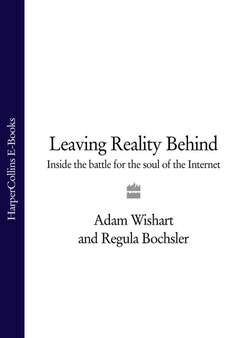Читать книгу Leaving Reality Behind: Inside the Battle for the Soul of the Internet - Regula Bochsler - Страница 5
Prologue
ОглавлениеAt 8.30 a.m. on 29 November 1999, seven lawyers arrived for a hearing on the fifth floor of the Los Angeles County Courthouse. They waited at the back of Department 53, a small, wood-panelled courtroom, for the judge to call the hearing to order. In preparation for this day, these lawyers had spent months submitting hundreds of pages of evidence and arguments to the court. Those on one team had determinedly manœuvred to prevent the hearing taking place at all; those on the other had offered increasing amounts of cash for a speedy resolution of the case. Now their arguments were to be heard in open court.
The plaintiff was a corporation, based ten miles away on the Californian coast in Santa Monica. The firm was personified by the character of its founder, Chief Executive Officer and archly self-described Uncle of the Board, Toby Lenk. This bald, slouch-shouldered thirty-eight-year-old had a fondness for mimicry and silly voices, and such a passion for work that at the time of the hearing he had gone for three years without taking the time off even to buy himself a pair of shoes. He had built his corporation – a toy shop – in less than a thousand days, with the dream to make life easier for parents and relations the world over. Like a fairytale come true, it was now worth $8 billion, and a darling of Wall Street. It was considered to be among the best companies of its kind and Lenk had filled it with only the smartest people, who between them could pack a trophy cabinet with their business diplomas from some of the world’s most prestigious universities. The Monday morning of the hearing followed a gang-busting Thanksgiving weekend during which Lenk’s toy shop had sold record numbers of Barbie Dolls and Star Wars figurines. Toby Lenk, it seemed, could do no wrong. The powerful global brand that he could proudly call his own was eToys.
The defendants had proved tricky to pin down. Indeed, eToys’ lawyers had failed to serve these renegades with all the necessary papers. They were supposedly at large somewhere in Europe; at the time of the hearing one of them, who calls himself agent.ZAI, was in the dank basement of a scruffy townhouse in a run-down neighbourhood in Zürich, Switzerland, eagerly awaiting news.
Physically as well as materially, the opponents were worlds apart. They were never to meet.
Zai was then a slim, diminutive, brown-haired twenty-eight-year-old who over time had nurtured his growing reputation in the arcane world of digital art. Meticulously he had constructed an art project that satirised the dot-com frenzy. Even before Lenk’s toy shop sold its first Mr Potato Head, Zai had described himself as the Chief Executive Officer of a group called etoy and behaved as if he was the leader of a global corporation. But in reality etoy had no employees and little corporate infrastructure. It did have a logo, a brand and a Web site and it sold a series of graphic posters that its members called ‘shares’. There was some seriousness to this apparently comic endeavour; it held up an intriguing mirror, as only art could, to a corporate and financial world that was being seduced by its own cheerleading. The etoy vision had been lent credibility and support beyond that received from the art world – even Austria’s Chancellor Viktor Klima had bought shares.
The legal suit filed by eToys in the Los Angeles Superior Court attacked the entire edifice of etoy’s ludicrous ‘corporate’ venture – its brand, trademark and greatest achievements – in a desperate attempt to shut down the artists’ Web site. Absurdly, the world’s most valuable toy shop had launched an explosive battery against the chimera, accusing etoy of ‘unfair competition’.
Neither Toby Lenk nor Zai made it to the courthouse. Lenk was busy finalising a deal to raise a further $150 million from his investors. Zai had not managed to get a flight to Los Angeles from Zürich over the busy Thanksgiving weekend. In any case, he had been advised that were he to step foot in America he might be arrested for securities fraud, one of the most heinous crimes against capital.
The details of how etoy and eToys built their respective companies and brands say much about the divergent histories of the Internet. On one hand was a new and fragile corporation that Wall Street pushed into the clouds. There eToys perfectly surfed a wave of euphoria about business and the capital markets, inspiring almost devotional loyalty because of the wealth the company created for its investors and employees and because of its customer-pleasing service culture. etoy, on the other hand, was a conceptual-art project that brilliantly summed up the times. It inspired a community that personified the Internet’s alternative history and was uneasy with its eventual corporate colonisation.
Both parties had spent years skilfully positioning themselves to benefit from the Internet goldrush. Now their values – monetary and moral – were clashing.
The conflict not only expressed the divides and fissures that had developed since the formation of the Internet; it also turned on an altogether larger dispute, concerning the very identity of the Internet. The reason for this acrimonious and hard-fought battle was a single, 250-line document now kept in a guarded, bomb-proof room in Herndon, Virginia: the key to the map of the Internet itself, through which domain names – Internet addresses like amazon.com or 4thestate.com – are controlled. The consequences of the domain battle were to play a central and decisive role in the Los Angeles courtroom.
By 10.30 a.m., Judge John P. Shook had stated his judgment. But this was not to be the end of the war …
